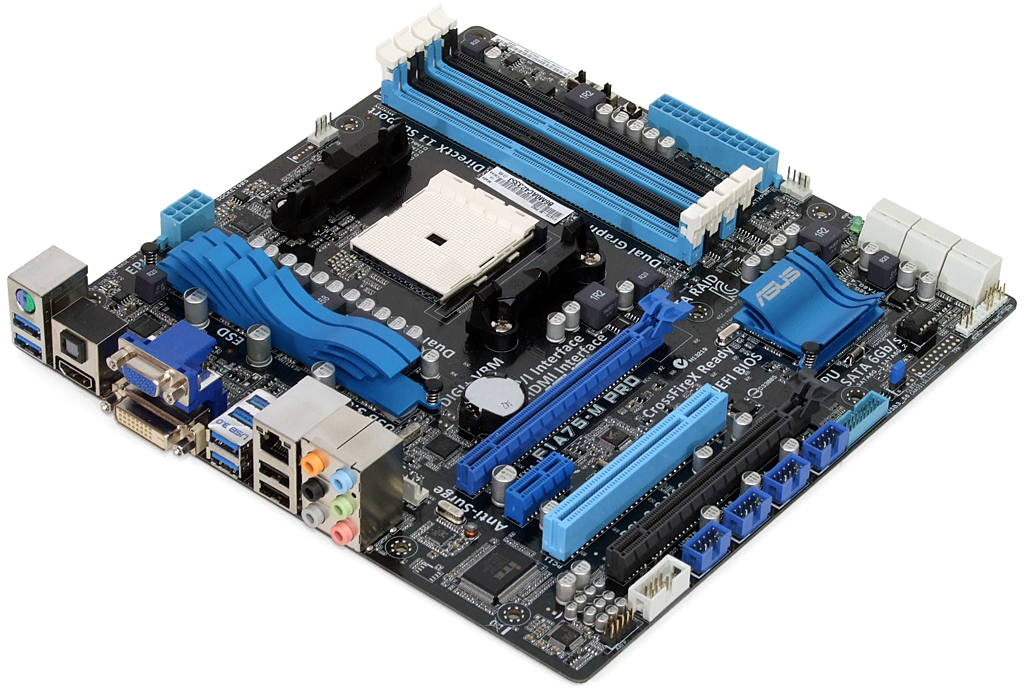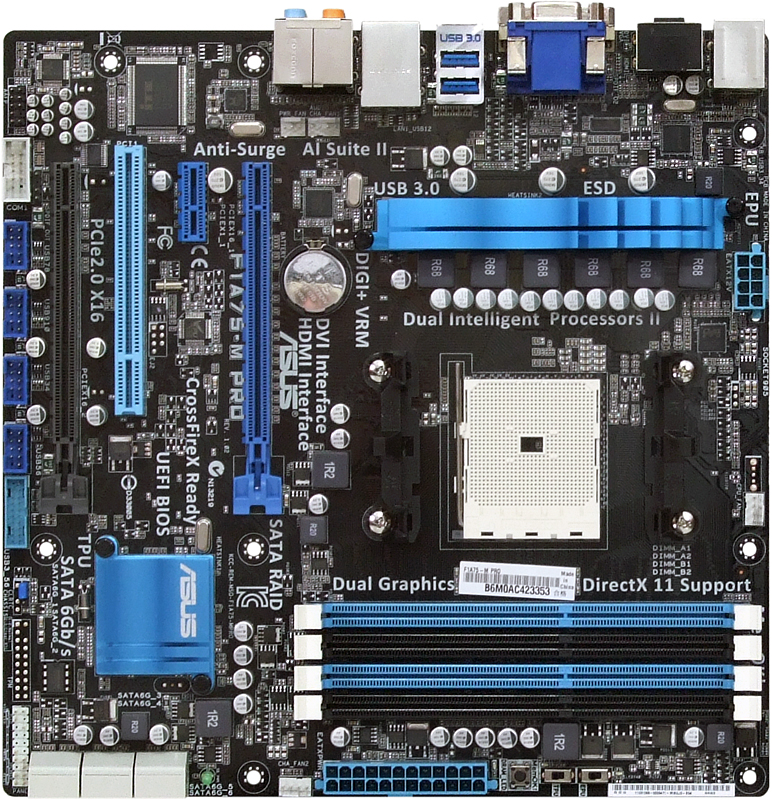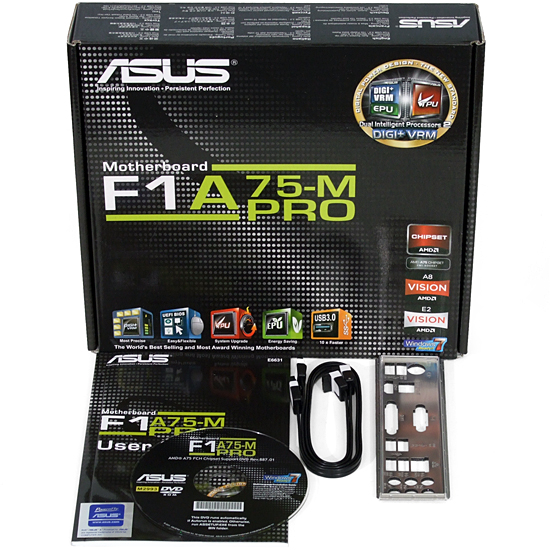Six A75-Based Motherboards For AMD’s A8 And A6 APUs
Advanced on-board graphics put AMD’s Llano-based APU far ahead of Intel’s Sandy Bridge architecture, at least when it comes to 3D apps. But you’ll still need a new motherboard to support the Socket FM1 platform. Today we test six affordable contenders.
Asus F1A75-M Pro
Asus’ F1A75-M Pro goes several steps beyond its low-cost competitors by providing more USB 3.0 connectivity, more on-board graphics options, and greater discrete graphics support.
Though the board lacks DisplayPort output, Asus has most monitors covered with its selection of HDMI, VGA, and DVI connectors. Users with two HDMI or two DVI monitors can even use an adapter on the other digital connector, since these are cross-compatible.
Four USB 2.0 ports ease the installation of front-panel bay devices, such as card readers, in addition to the traditional port extension cables. Internal USB 3.0 is also available in addition to the I/O panel’s four ports, since two of the rear ports are interfaced through a third-party PCIe-based controller.
Llano-based APUs have twenty PCIe 2.0 lanes, so Asus adds a second graphics card slot capable of running in x4 mode. While that might be fast enough for certain mid-range 3D cards, its probably most useful for adding displays that won't be tasked with gaming. And choose carefully. A dual-slot card in that bottom slot would almost certainly conflict with the USB 2.0 and 3.0 headers lining the board's bottom edge.
Switches on the side support Asus’ TPU automatic-overclocking utility and EPU energy saving modes, while the MemOK button underclocks memory to make it easier to boot up with low-quality modules installed.
Like its lower-cost rivals, the F1A75-M Pro only includes two SATA cables. While we would have liked to see four cables accompany such a fully-featured board, we earnestly question why Asus didn’t include at least three.
Get Tom's Hardware's best news and in-depth reviews, straight to your inbox.
Current page: Asus F1A75-M Pro
Prev Page Overclocking ASRock's A75M Next Page Overclocking Asus' F1A75-M Pro-
dogman_1234 Thank You for the Review. I am glad to see you guys taking this and pushing it to the limits. Can't wait until SB-E and Bulldozer reviews.Reply
Qne question, what does the APU,( either the A6 or the A8), have on F@H applications? -
Crashman dogman_1234Thank You for the Review. I am glad to see you guys taking this and pushing it to the limits. Can't wait until SB-E and Bulldozer reviews.Qne question, what does the APU,( either the A6 or the A8), have on F@H applications?Since I haven't joined F@H, I can only recommend going to a F@H forum to find someone who's tried it.Reply
I know F@H is a great cause, might cure cancer etc, but wouldn't it be more geeky to search for radio signals of little green men? -
_Pez_ what about blue-ray playback? and power consumption when playing it. I'm planing a HTPC. And those small form factor are really appealing. especially Gigabyte’s A75M-UD2H, I will get that one.Reply -
Crashman _Pez_what about blue-ray playback? and power consumption when playing it. I'm planing a HTPC. And those small form factor are really appealing. especially Gigabyte’s A75M-UD2H, I will get that one.SFF properly translates to DTX and Mini ITX. These are Micro ATX...Reply
I checked the CPU reviews and didn't see anything there either. You know it's going to be low utilization for these processors, which means it will be closer to the idle power than to the full-load power... -
buzznut I remember when the Gigabyte board first was launched, I though it looked pretty sweet then even posted a poll on it. I'd have to agree, it seems like the board to have for A8. Looks good too, although I a find Gigabyte's non-blue/white scheme offerings more attractive. Just ordered my 990FX UD5, can't wait!Reply -
buzznut CrashmanSFF properly translates to DTX and Mini ITX. These are Micro ATX...I checked the CPU reviews and didn't see anything there either. You know it's going to be low utilization for these processors, which means it will be closer to the idle power than to the full-load power...Reply
I think micro atx fits into plenty of SFF cases. Maybe we need to redefine..
I'd like to see a showdown of mini itx boards though, I think Anand did something like that recently. That's probably where the A8 CPU's need to go head to head with atom anyway, most reviews I've seen show the CPU's aren't all that cut out for desktop. Maybe the next batch that comes out in Q4/Q1 2012 will be better for desktop. -
tacoslave buzznutI think micro atx fits into plenty of SFF cases. Maybe we need to redefine..I'd like to see a showdown of mini itx boards though, I think Anand did something like that recently. That's probably where the A8 CPU's need to go head to head with atom anyway, most reviews I've seen show the CPU's aren't all that cut out for desktop. Maybe the next batch that comes out in Q4/Q1 2012 will be better for desktop.lol wut? Dude you got this QUAD CORE based on the phenom II architecture mixed up with the e-350 or the c-50 those are the ones that are going up against Atom.Reply
-
Crashman buzznutI think micro atx fits into plenty of SFF cases. Maybe we need to redefine.That would make you part of the problem rather than part of the solution.Reply
1.) SFF originally stood for Shuttle Form Factor and was proprietary, using 2-slots.
2.) It was copied by companies like First International Computer and AOpen
3.) AMD established a standard for "open architecture" systems of similar design, called DTX.
4.) ITX is smaller than DTX and fits DTX cases.
Notice this has nothing to do with Micro ATX. People who claim that anything shaped like a cube is SFF need only be shown a full ATX cube before they start making excuses. People who point to horizontal cases and say SFF need only look at ancient AT desktops before they're forced to come up with excuses.
2-slots. That's what makes Shuttle copies different from everything else. Cubes can be any "size", HTPC's can be any "size", if SFF is a size standard it can only be used to apply to two-slot cases.
Some competitors have been trying for years to expand the definition of SFF. They are, of course, wrong.
Nobody's perfect, one of Tom's old team members once said that barebones always refers to SFF systems (even though full sized barebones existed long before SFF). But at least Tom's tries to fix those types of errors rather than force them into the vernacular.
I'm just asking people to be specific. If you mean cube, say cube. If you mean desktop, say desktop. If you mean mini-tower, slim tower, or slim desktop, just say it. Then apply a form factor "Mini ITX slim tower" or "Micro ATX desktop". And if you're saying "SFF" rather than media center, well it's obvious that SFF can do other things so just be specific and say media center.
If you're not specific, you might find yourself in a discussion about what the meaning of "is" is.
-
noob2222 I have the gigabyte board and undervolted by .2 running stock speeds. Its used for my HTPC setup so for me making it silent and less power draw were the key points. I have an oversized fanless heatsink and never have issues. When I do run a game on it for fun, the case fan will kick up, but watching movies it stays silent.Reply
Would love to see some benches on the gigabyte with those max overclock numbers as the GPU would benefit greatly from the memory oc. -
Crashman noob2222I have the gigabyte board and undervolted by .2 running stock speeds. Its used for my HTPC setup so for me making it silent and less power draw were the key points. I have an oversized fanless heatsink and never have issues. When I do run a game on it for fun, the case fan will kick up, but watching movies it stays silent.Would love to see some benches on the gigabyte with those max overclock numbers as the GPU would benefit greatly from the memory oc.Good News! Tom's Hardware is working on a memory article using one of these boards, and has included games in the test!Reply



